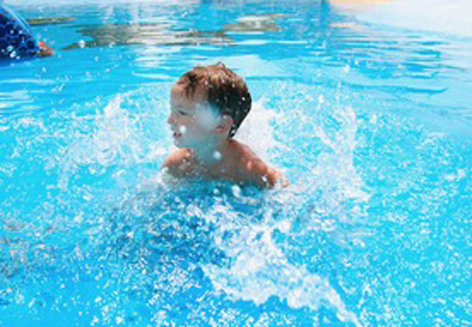It is important to distinguish whether your child only got water in their face and mouth or whether they actually fell into the water.
➔ If your child has got water in their mouth but has not fallen into the water:
Pick up your child, calm them down, maintain eye contact, and gently pat them on the back between the shoulder blades to help them cough.
➔ If your child falls into the water, it must be rescued immediately!
When rescuing from water, many children first hold their breath, as if in shock, but then start breathing again after this brief moment.
➔ When a child is very scared, their glottis, the opening between the vocal cords in the larynx, can cramp.
Calm down your child immediately, pat him on the back, speak to him and give him a big blow in the face. This often releases the spasm and the child begins to breathe again.
Wrap your child in a blanket to prevent hypothermia. Remember, even relatively warm water can lead to hypothermia.
NEVER shake your child or hold them upside down with their legs in the air to remove water from their lungs. You can’t remove water like this.
If you are not sure whether everything is okay, have your child examined by a doctor after a water spill.
➔ If your child does not start to breathe after being rescued from the water, regardless of whether they are responsive or unconscious, IMMEDIATELY tell someone else that they have to call the lifeguard and call the EMERGENCY CALL (144 in Switzerland, and in your holiday country ??? ).
If your child is RESPONSIBLE (i.e. conscious), lay them on their back on the floor and ventilate them five times through their mouth. You need to see your rib cage rise so you know if you have been successful. If your child is breathing but not yet responding, place them on their side in a stable position.
If a child is unconscious (no longer responsive), check immediately that the child is breathing.
As the child breathes, place them on their side in a stable position.
If the child is not breathing, start the resuscitation IMMEDIATELY. For children this means starting with five breaths, then alternating between 30 chest compressions (chest compressions) and 2 breaths. Do this until medical help arrives.
When was your last first aid course? Maybe it’s time to brush up on your skills.
Posted on June 16, 2021 by admin
This entry was posted in Blog. Bookmark the permalink.

